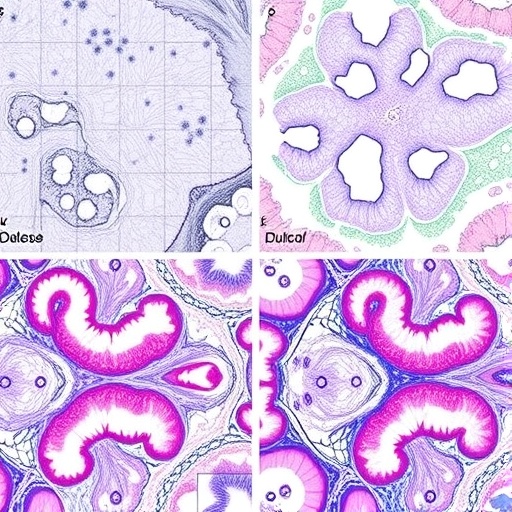In the ever-evolving field of clinical proteomics, accurate amyloid subtyping has become a cornerstone in diagnosing and managing amyloidosis, a complex and often underappreciated group of diseases. Recent advances in analytical techniques, most notably mass spectrometry and immunohistochemistry, have provided unprecedented insights into the nature of amyloid proteins. Researchers in Brazil have undertaken a rigorous study to assess the consistency of these methodologies, presenting findings that could shift paradigms in clinical practice. Their exploration reveals not only the technical capabilities of these tools but also sheds light on the translational implications for patient care and disease management.
The study conducted by Szor, Castelli, Schuch, and their colleagues represents a meticulous inquiry into how effectively mass spectrometry can be integrated into clinical diagnostic frameworks alongside traditional histopathological techniques. With amyloidosis often manifesting through heterogeneous clinical presentations, the need for precision in subtype classification cannot be overstated. Subtypes such as AL, AA, and ATTR, identified by the nature of the precursor proteins, underscore the need for reliable methods to distinguish between them, as this directly influences therapeutic decisions and prognostic assessments.
Mass spectrometry, a powerful analytical technique, offers the capacity for high-throughput, sensitive detection of proteins at the molecular level. In the Brazilian study, the researchers evaluated how well mass spectrometry could complement immunohistochemistry, which has long been the gold standard for protein localization and visualization in tissue samples. Traditionally, immunohistochemistry has relied on the specificity of antibodies to bind distinct amyloid proteins, providing qualitative insights into their presence but lacking the quantitative prowess of mass spectrometric analyses. The integration of these techniques is not merely additive; it represents a seismic shift in how pathologies like amyloidosis are understood and managed.
The researchers meticulously outlined their methodology, establishing a clinical-laboratory model designed for robustness and reproducibility. Utilizing paired tissue samples from amyloidosis patients, they implemented rigorous controls to evaluate both methods. Their data revealed a high concordance between mass spectrometry results and traditional immunohistochemical staining, providing compelling evidence that these two approaches can reliably support one another. This finding is particularly noteworthy considering the potential for discrepancies that can arise from sample handling, antibody specificity, and variability in histopathological interpretation.
Furthermore, the implications of their findings extend beyond the laboratory. In clinical settings characterized by limited resources, the incorporation of high-throughput proteomic techniques such as mass spectrometry can democratize access to advanced diagnostic capabilities. This is especially relevant in a diverse country like Brazil, where disparities in healthcare access have long posed challenges in delivering timely and accurate diagnostic services. The researchers advocate for the broader adoption of these technologies to enhance the early detection of amyloid conditions, which is crucial for effective intervention and improved patient outcomes.
Additionally, their findings emphasize the potential for developing standardized protocols that incorporate these sophisticated methodologies into routine practice. With a focus on reproducibility, the authors highlight the importance of training and certification programs for laboratory personnel, ensuring that the administrative aspects of clinical proteomics uphold the same high standards as the technical aspects. This perspective underscores the collaborative nature of scientific advancement, necessitating partnerships between researchers, clinicians, and pathologists to foster an environment where innovation translates into improved healthcare delivery.
The broader scientific community stands to benefit from these insights, as they contribute to a growing body of literature advocating for a multi-modal approach to protein analysis in clinical diagnostics. By bridging the gap between traditional histopathological practices and modern molecular techniques, the research team opens avenues for further investigations into other protein misfolding disorders. Their findings suggest that a similar translational approach could enhance the understanding of conditions like Alzheimer’s disease and other tauopathies, which share underlying pathophysiological mechanisms with amyloidosis.
As the landscape of clinical proteomics continues to unfold, the results from this Brazilian research initiative serve as a clarion call for more comprehensive studies to investigate the full spectrum of amyloid subtypes and their clinical ramifications. As new biomarkers are identified and characterized through advanced proteomic approaches, the potential for personalized medicine in treating amyloidosis becomes increasingly tangible. Future research in this arena could elucidate novel therapeutic targets and refine existing treatments, paving the way for innovative interventions tailored to the unique pathology of each patient.
Moreover, the practical implications of these findings resonate with the push for more nuanced clinical guidelines that accurately reflect the complexities of amyloid subtyping. As the healthcare landscape increasingly leans toward evidence-based practice, the data provided in the study enhances the breadth of knowledge available to clinicians, enabling them to make informed decisions rooted in science rather than tradition. This aspect of research illustrates a fundamental dynamic in medical science, where empirical inquiry continually reshapes understanding and enhances patient care.
The balance between clinical requirements and scientific advancement also raises important considerations regarding regulatory frameworks for the implementation of new diagnostic technologies. The authors recognize that integrating mass spectrometry into clinical laboratories will require navigating a complex landscape of regulations and guidelines, emphasizing the importance of advocacy for legislative support. Engaging with health authorities and industry stakeholders is vital to standardize practices that place patient welfare at the forefront of innovation.
The results from the Brazilian team’s study stand as a testament to the rigorous science underpinning clinical proteomics. As they continue to validate and refine their methodologies, the implications of their work echo across disciplines, urging a re-examination of how diseases like amyloidosis are diagnosed and treated. The integration of advanced technologies into routine practice may soon become the norm rather than the exception, an evolution that promises to improve outcomes for countless individuals affected by these challenging conditions.
In conclusion, the work of Szor, Castelli, Schuch, and their colleagues herald the dawn of a new era in amyloid subtyping. Their endeavors emphasize not just the technical achievements but also their potential impact on clinical practice and patient care. As we await further developments and validations of their findings, it is clear that this Brazilian experience is but a glimpse of what the future holds for clinical diagnostics in the era of precision medicine.
Subject of Research: Amyloid subtyping consistency in clinical diagnostics
Article Title: Assessing the consistency of mass spectrometry, a clinical-laboratory model, and immunohistochemistry in amyloid subtyping: a Brazilian experience.
Article References: Szor, R.S., Castelli, J.B., Schuch, R.A. et al. Assessing the consistency of mass spectrometry, a clinical-laboratory model, and immunohistochemistry in amyloid subtyping: a Brazilian experience. Clin Proteom 22, 35 (2025). https://doi.org/10.1186/s12014-025-09546-4
Image Credits: AI Generated
DOI: [Not provided]
Keywords: amyloidosis, mass spectrometry, immunohistochemistry, amyloid subtyping, clinical diagnostics, proteomics, Brazil
Tags: amyloid protein analysis techniquesamyloidosis diagnosis and managementclinical applications of proteomic technologiescomparative analysis of mass spectrometry and immunohistochemistryemerging trends in clinical diagnosticsheterogeneity in amyloidosis presentationsimmunohistochemistry for amyloid subtypingmass spectrometry in clinical proteomicsprecision medicine in amyloidosissubtyping amyloid diseases AL AA ATTRtechnical consistency in amyloid detectiontranslational implications of diagnostic methods





